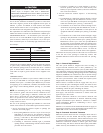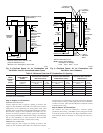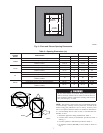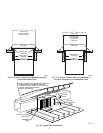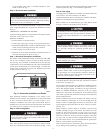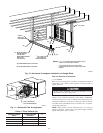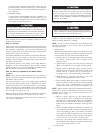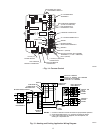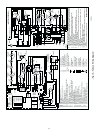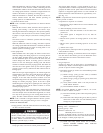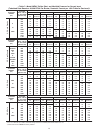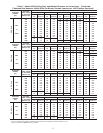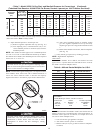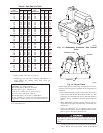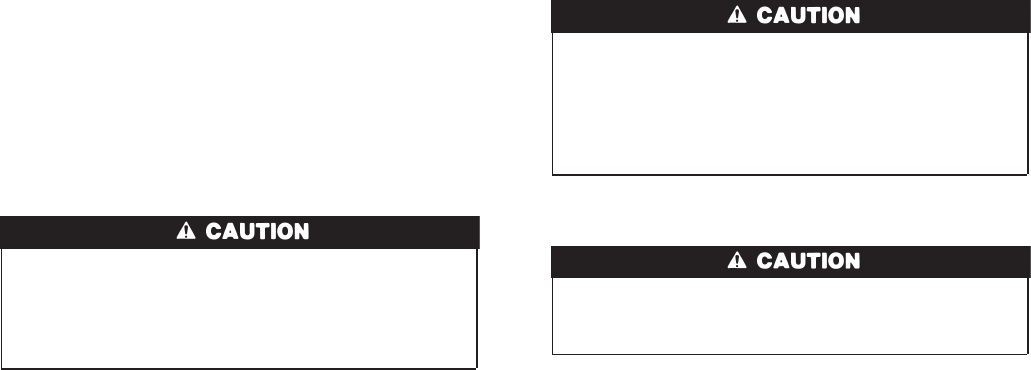
Two quick-connect terminals marked EAC-1 and EAC-2 are
provided for EAC connection. (See Fig. 14.) These terminals
are energized with 115-v, (1.5-amp maximum) during blower
motor operation.
2. Humidifier (HUM)
A quick-connect terminal (HUM) and screw terminal (C
OM)
are provided for 24-v humidifier connection. (See Fig. 16.)
HUM terminal is energized with 24-v (0.5-amp maximum)
after inducer pressure switch closes.
Do not connect furnace control HUM terminal to HUM
(humidifier) terminal on Thermidistat™, Zone Controller, or
similar device. See Thermidistat, Zone Controller, thermostat,
or controller manufacturer’s instructions for proper connec-
tion. A failure to follow this warning could result in fire.
NOTE: A field-supplied, 115-v controlled relay connected to
EAC terminals may be added if humidifier operation is desired
during blower operation.
Step 11—Venting
Refer to the national or local installation code such as NFGC in the
United States, or the NSCNGPIC in Canada for proper vent sizing
and installation requirements. Use the enclosed Installation In-
structions (Single-Stage Vent Tables for Category I Fan-Assisted
Furnaces) for a quick, easy reference.
After fully assembling the vent connector to the furnace flue collar,
securely fasten the vent connector to the collar with two field-
supplied, corrosion-resistant, sheet metal screws located 180° apart
and midway up the collar.
The horizontal portion of the venting system shall maintain a
minimum of 1/4-in. upward slope per linear ft and it shall be
rigidly supported every 5 ft or less with hangers or straps to ensure
that there will be no movement after installation.
Step 12—Start-up, Adjustment, and Safety Check
GENERAL
NOTE: Proper polarity must be maintained for 115-v wiring. If
polarity is incorrect, control status indicator light will flash rapidly
and furnace will not operate.
The furnace must have a 115-v power supply properly connected
and grounded. Proper polarity must be maintained for correct
operation. Thermostat wire connections at R, W, C, and Y must be
made at the furnace 24-v terminal block on the control board. The
gas service pressure must not exceed 0.5 psig (14-in. wc), but must
be no less than 0.16 psig (4.5-in. wc).
Before operating the furnace, check each manual reset switch for
continuity. If necessary, press the button to reset the switch.
The blower compartment door must be in place to complete the
115-v circuit to the furnace.
This furnace is equipped with 2 manual reset limit switches in
the gas control area. The switches will open and shut off
power to the gas valve if a flame rollout or an overheating
condition occurs in the gas control area. DO NOT bypass the
switches. Correct inadequate combustion air supply problem
and reset the switches.
SEQUENCE OF OPERATION
Furnace control must be grounded for proper operation or
control will lockout. Control is grounded through green wire
routed to gas valve and burner bracket screw.
Using the schematic diagram shown in Fig. 16, follow the
sequence of operation through the different modes. Read and
follow the wiring diagram very carefully.
NOTE: If there is a power interruption and any thermostat call,
the control will initiate a 90-sec blower only on period before
starting another cycle.
1. Heating mode
When the thermostat "calls for heat," R-W circuit closes. The
furnace control performs a self-check, verifies the pressure
switch contacts are open, and starts the inducer motor.
a. Prepurge period—As the inducer motor comes up to speed,
the pressure switch contacts close to begin a 15-sec
prepurge period.
b. Igniter warm-up—At the end of the prepurge period, the
igniter is energized for a 17-sec igniter warm-up period.
c. Ignition sequence—When the igniter warm-up period is
completed, the gas valve opens, permitting gas flow to the
burners where it is ignited. After 5 sec, the igniter is
de-energized and a 2-sec flame-sensing period begins.
d. HUM terminal is energized with the gas valve. See
Accessories in Electrical Connections section.
e. Flame-sensing—When burner flame is sensed, the control
begins the blower on delay period and continues holding
the gas valve open. If burner flame is not sensed, the
control closes the gas valve and repeats the ignition cycle.
NOTE: Ignition sequence will repeat 3 additional times before a
lockout occurs. Lockout automatically resets after 3 hr, or can be
manually reset by turning 115v off (not at thermostat) for 3 sec
minimum, then on again.
f. Blower on delay—Forty-five sec after burner flame is
proven, the blower motor is energized on heating speed.
Simultaneously, terminals HUM and C
OM-24V for humidi-
fier, and EAC-1 and EAC-2 for EAC are energized. If
jumper is on pin 6 and pin 9, the blower on delay period is
66 sec.
g. Blower off delay—When the thermostat is satisfied, the
circuit between R and W is broken, de-energizing the gas
valve and stopping gas flow to the burners. The blower
motor, and EAC remain energized 90, 135, 180, or 225 sec
(depending on the blower off time selection). The furnace
is factory set for a 135-sec blower off delay period.
h. Post-purge—The inducer motor remains energized 5 sec
after the burners are extinguished. If jumper is on pin 6 and
pin 9, the post-purge period is 15 sec.
2. Cooling mode
12




